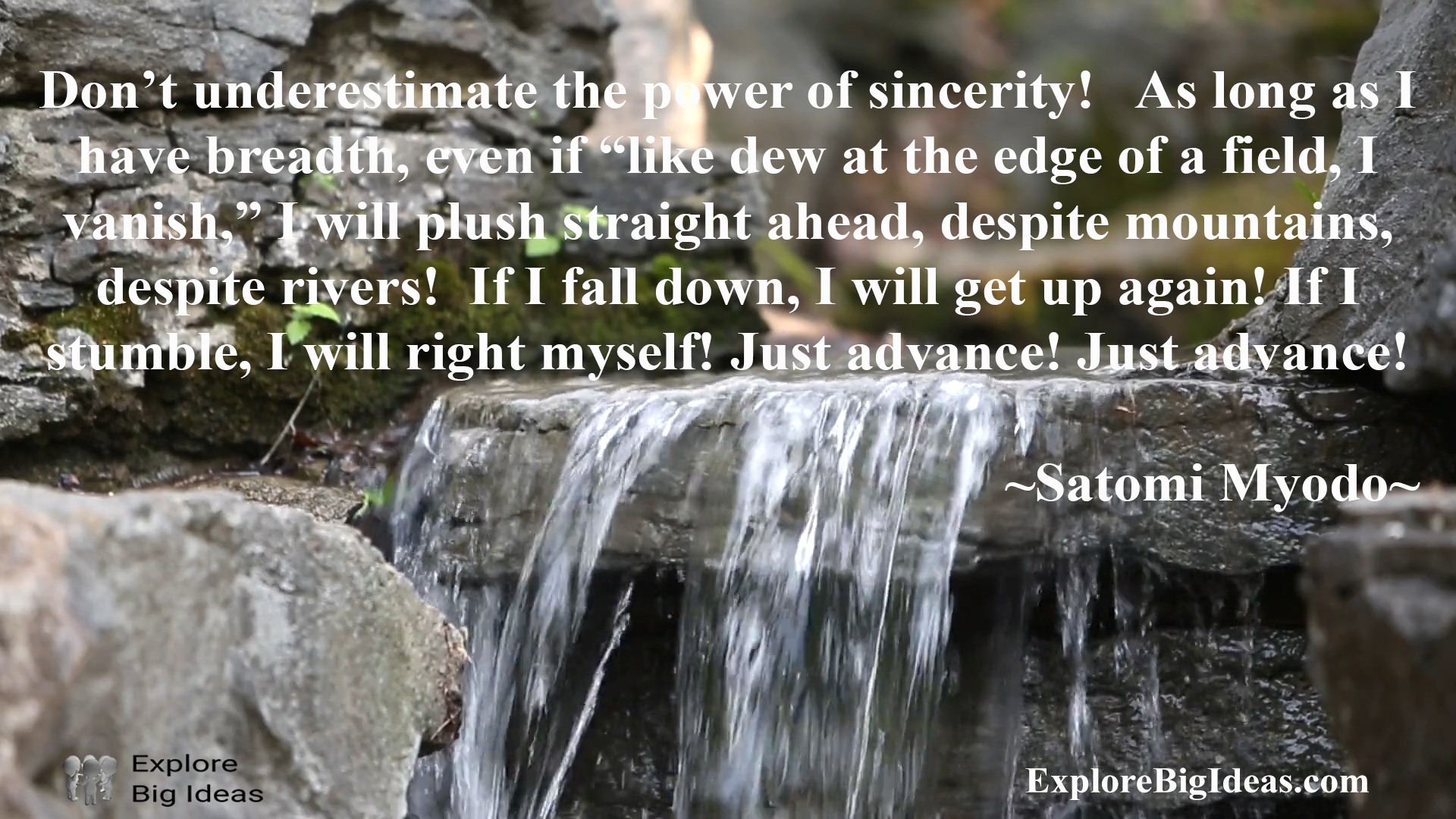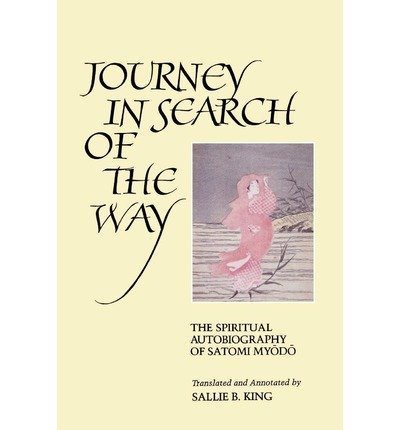Do not miss the video version of the above meme quote on determination from the Zen Master Satomi Myodo located at the bottom of the the page. We study Myodo in our Journey Through Religion course here at Explore Big Ideas.
The Extraordinary Life and Awakening of
a 20th Century Zen Pioneer
Satomi Myodo’s life story is an intricate tapestry woven from threads of hardship, spiritual hunger, and unwavering resolve. Her story stands as a testament to the transformative power of Zen in the modern world. Though relatively less known in the West, Satomi Myodo’s journey from rural peasant life through personal tribulation and ultimately to spiritual awakening stands as an inspirational beacon for seekers everywhere.
Early Life: Roots in Rural Japan
Satomi Myodo (1882–1978) was born in a small village in the northern prefecture of Aomori, Japan, during a period of rapid societal change. Her birth name was Fumiko Satomi, and she grew up in a traditional Japanese household that adhered to the customs and expectations of the Meiji era. At the time, opportunities for women were limited, especially in rural areas, and the expectation was that girls would grow into dutiful wives and mothers.
From an early age, Satomi exhibited a keen sense of curiosity and a contemplative disposition. Her days were spent helping with household chores and farm work. Still, she was drawn to the stillness of nature and the subtle rhythms of the seasons—experiences that would later inform her spiritual practice.
Struggles and Seeking: The Search for Meaning
Satomi’s early life was marked by adversity. She married young, as was customary, but her marriage proved to be fraught with challenges, including the deaths of several children. These personal tragedies, coupled with the restrictive societal expectations placed upon her as a woman, drove Satomi into a period of deep existential questioning. She longed for meaning beyond the boundaries of social convention and family duty.
In a time and place where women’s voices were rarely heard in spiritual matters, Satomi’s search for purpose was both radical and courageous. She began reading widely, exploring Buddhist texts and folk beliefs. This quest for truth, however, did little to ease her suffering, and she was often overwhelmed by a sense of spiritual isolation.
Encounter with Zen Buddhism
It was during this period of turmoil that Satomi was introduced to the teachings of Zen Buddhism. She was captivated by Zen’s emphasis on direct experience and inner transformation and soon sought out a teacher who could guide her in this pursuit. Satomi’s determination led her to Daichi-ji, a Soto Zen temple, where she met her first Zen master. Despite initial resistance from the all-male sangha—a reflection of prevailing gender biases—her sincerity and commitment earned her begrudging respect.
Satomi immersed herself in rigorous meditation (zazen), long hours of silence, and the study of koans. She confronted the ego’s illusions head-on and endured the physical hardships of monastic life. Throughout these years, Satomi’s perseverance was tested. She faced not only the usual difficulties of Zen practice—pain, boredom, doubt—but also the added weight of being a rare woman in the male-dominated world of Japanese Zen.
The Turning Point: Meeting Harada Daiun Sogaku
Satomi’s journey would reach a pivotal moment when she encountered the great Zen master Harada Daiun Sogaku (1871–1961), who would become her most influential teacher. Harada Roshi was renowned for his reformist attitude and his willingness to teach laypeople and women alongside monks—a radical departure from the prevailing Zen orthodoxy.
Satomi studied under Harada at Hosshin-ji monastery, enduring the intensive sesshin (retreats) and the piercing scrutiny of Harada’s teaching. Harada Roshi recognized Satomi’s depth of commitment and encouraged her to further explore the nature of the self. Under his guidance, Satomi plunged into the heart of Zen practice, wrestling with koans and meditating through the night.
Great Doubt and Awakening
The crucible of intensive practice eventually brought Satomi to the brink of despair. She was gripped by what Zen masters call “Great Doubt”—an existential crisis that shakes one to the core. In this darkness, Satomi pressed on, refusing to yield to fear or self-pity. Then, during a period of relentless zazen, she experienced a profound awakening, known as kensho. The sense of separation fell away, and she realized the unity of all things, vividly experiencing the emptiness and impermanence that Zen teachings point toward.
Satomi’s awakening was recognized by Harada Roshi, marking her as a true successor in the Zen lineage. This recognition was deeply significant, especially in an age when few women were acknowledged as authentic Zen masters.
Life as a Zen Teacher and Healer
After her awakening, Satomi Myodo devoted the remainder of her life to spiritual practice and teaching. However, she never established a conventional temple or monastery. Instead, she returned to her native region, offering guidance to lay practitioners, especially women who had been excluded from traditional Buddhist training. Satomi’s approach was compassionate and practical, emphasizing the direct experience of awakening over ritual or dogma.
She became known for her healing presence and her ability to see through people’s suffering to the root of their delusions. Her students reported that simply being in her presence could bring clarity and peace. Satomi’s teaching style was free from pretense; she spoke in plain language, used examples from everyday life, and encouraged her students to question everything—even her own words.
Later Years and Legacy
Satomi Myodo lived a long and fruitful life, continuing her teaching and healing work well into her nineties. She wrote several memoirs and essays, the most famous of which is The Mud and the Pure Water, where she reflects candidly on her struggles and insights. Through her writings, Satomi offered a rare window into the inner life of a woman Zen practitioner, inspiring a new generation of seekers in Japan and beyond.
Her influence extended to other notable Zen figures, such as Shundo Aoyama Roshi and Yamada Koun Roshi, who credited Satomi with helping to pave the way for greater inclusion of women in Zen practice. Today, Satomi’s legacy lives on in the growing number of Zen temples and centers around the world that welcome both men and women as full participants in spiritual life.
Teachings and Philosophy
A radical honesty and an insistence on personal responsibility marked Satomi Myodo’s teachings. She believed that enlightenment is not a distant goal, but an ever-present reality that can be realized during daily life. Satomi urged her students to look directly at their minds, to embrace suffering as a teacher, and to find liberation in the ordinary.
She often spoke of the “mud and pure water” as symbols of the human condition: suffering and enlightenment are not separate but inextricably intertwined. True wisdom, she taught, arises not from escaping pain, but from meeting it fully and discovering the freedom that lies on the other side.
Satomi was also an advocate for women’s spiritual empowerment. She challenged the cultural norms that limited women’s roles in religious life and encouraged her female students to trust their own experience of awakening. In this way, Satomi Myodo played a vital role in the revitalization of Japanese Zen in the twentieth century.
Conclusion: The Enduring Spirit of Satomi Myodo
Satomi Myodo’s life is a powerful example of courage, resilience, and spiritual wisdom. From her humble beginnings in rural Japan to her recognition as an awakened Zen master, Satomi walked the path of the Bodhisattva with unwavering determination. Her story continues to inspire those who seek a deeper understanding of themselves and the world.
In the annals of Zen, Satomi Myodo’s name stands as a reminder that the true heart of the Dharma knows no boundaries of gender, class, or circumstance. Her legacy endures in the countless lives she touched—and in the silent, boundless presence at the core of all things.



